
Schematic diagram of the in-orbit operation of the computing power satellites planned by the Beijing Astro-future Institute of Space Technology. [Photo provided to chinadaily.com.cn]
An institute in Beijing is preparing to launch its first new type of high-computing-power experimental satellites by late 2025 or early 2026, as China seeks new ways to meet surging demand for computing power amid global energy constraints driven by artificial intelligence, experts said on Thursday.
"Large-scale data centers have expanded rapidly worldwide, but further growth faces major obstacles, including heavy land use, soaring energy consumption and limits on atmospheric cooling," said Zhang Shancong, director of the Beijing Astro-future Institute of Space Technology and chief scientist at Beijing Orbit Twilight Technology Co.
Space-based solutions offer abundant solar energy and the stable minus 270 C cosmic environment, enabling continuous solar power generation and highly efficient passive radiation cooling — a potentially groundbreaking approach to meeting future computational needs, according to the Beijing institute.

An institute in Beijing is preparing to launch its first new type of high-computing-power experimental satellites by late 2025 or early 2026, as China seeks new ways to meet surging demand for computing power amid global energy constraints driven by artificial intelligence, experts said on Thursday. [Photo provided to chinadaily.com.cn]
The institute plans to build a constellation of 16 centralized space data centers in a dawn-dusk orbit 700 to 800 kilometers above Earth. The orbit would allow near-continuous access to solar power, supplying an estimated 16 gigawatts to the network.
Zhang said development will unfold in three stages. From 2025 to 2027, the team will test key technologies needed to power and cool computers in orbit, and several trial computing satellites and data-relay satellites will be launched. Computing capacity is expected to grow as more satellites join the network.
The second stage, from 2028 to 2030, will focus on reducing the cost of space-based computing so it becomes comparable to running data centers on the ground.
The final stage, from 2031 to 2035, aims to build much larger orbital facilities powered by vast amounts of solar energy that could one day support the training and operation of advanced AI systems directly in space.